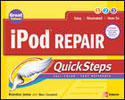
iPod Repair QuickSteps
Brandon Jones and Marc Campbell
McGraw Hill Osborne
http://www.osborne.com
161 pages
ISBN 978-0-07-149866-1
US $19.95
CA $23.95
iPods have become one of the most popular symbols of today’s digital culture. iPods are seen on Wall Street, Main Street, the South Bronx, and down on the farm.
The original iPod, with all of 5GB of storage space, retailed for $399. Today, you can buy a 4 GB nano for $149. A 160 GB iPod (that’s 32 times the original’s storage capacity) costs $349, $50 less than the original.
With the inexorable drops in price for all iPod models, they’ve certainly become ubiquitous. But have they become disposable? What if the battery gives out? What if it won’t start up? Toss it, or fix it?
Apple, of course, will replace your battery, and any other broken part that may have succumbed to various indignities that portable electronics have to endure. But Apple charges a lot. Can you change the battery yourself? Can you fix a more serious problem on your own?
Jones and Campbell may have the answer. iPod Repair QuickSteps is a wide-format book of text and photos that leads you through most any iPod repair. First, the reader is told exactly how to identify each version of iPod and iPod Nano, as each repair differs, depending on the unit you have. Battery swaps are only the starting point; the authors provide guidance for replacing broken screens, bad logic boards, inoperative audio jacks, toasted hard drives, and more.
The book is well designed. Each topic, Replacing the Logic Board, for example, is divided into sections for each generation of iPod and Nano. Each repair is rated for difficulty, from Easy to Moderate to Hard, to Not Recommended. The book is brimming with photos of each critical step, and the text explanations are generally clear and concise.
While I was impressed with iPod Repair QuickSteps, I have one concern. If you’ve never opened up a piece of consumer electronics before, you may quail when you actually get it opened, and are staring at a bunch of wires and circuits that somehow no longer looks like the photos in the book.
Panic may set in! Don’t panic. My own personal fright was from the first time I changed to battery in my 4G iPod. After reading the instructions (not from iPod Repair QuickSteps) I still was nervous about the amount of force I needed to use to open the iPod. I got it open, but I was afraid I’d ruin the case.
This fear is one thing a book like iPod Repair QuickSteps may not be able to address. I for one would NEVER make a logic board replacement or a screen swap my first iPod repair. Work your way in gradually, perhaps starting with a battery swap.
That’s my second concern with iPod Repair QuickSteps. The book provides good instructions for even the most complex repairs, and makes them seem easy. Many of them are easy, But if you choose to jump into the deep end of the iPod repair pool your first time, keep your cool if it looks like you’re over your head.
But if your iPod was dead to begin with, one could say that you have nothing to lose, so why not? If you botch the repair, you can always send it out to a professional iPod repair shop, and those are plentiful.
Conclusion
iPod Repair QuickSteps is a great resource for people who want to repair a broken iPod. Be aware that many repairs are not suited to novice Podworkers, even though the authors make even the hardest work looks easy.

Leave a Reply
You must be logged in to post a comment.